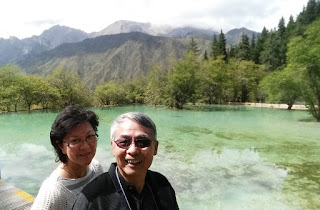Our round trip driving tour to Terengganu and Kelantan covered a total distance of some 1,350 Km. We passed through Pahang and stopped for our first break in Bentong before proceeding to Kuala Gandah Elephant Conservation Centre to look at the elephants.
We spent a night at Cukai (now renamed Kemaman) which was our first stop in Terengganu. From Cukai, we took the coastal road passing through Kerteh, Paka, Dungun, Marang and then to Kuala Terengganu. After two nights in Terengganu, we moved on to Kota Bharu in Kelantan. The trip ended after two days stay in Kota Bharu.
Since the distance from Kota Bharu to KL is 440 Km which could be too demanding to drive at one go, we decided to take a break and spend a night in Gua Musang. From Kota Bharu to Gua Musang, we also took a detour to Rantau Panjang, a border town at the Thai border at the northern boundary of Kelantan.
As it turned out, my greatest surprise was Gua Musang, a name synonymous with Tengku Razaleigh Hamzah, the MP for Gua Musang. This is because of Tengku Razaleigh long history as an MP for Gua Musang. He is the incumbent MP since 1986, his 7th term since he won in the 7th Parliamentary Election in 1986.
When I asked the Inn Keeper in Gua Musang for interesting places to visit, without hesitation, he recommended a little town called Pulai, 14 Km away.
Pulai, tucked away in the middle of Malaya Penisular and next to a small river Sungai Galas is a Chinese settlement. According to the chap I had a lengthy chat with, Chinese in Pulai is 99.9% Hakka. Their Hakka accent as I discovered first hand is identical to the spoken Hakka in Sabah. The Hakka in Sabah and the Hakka in Pulai all came from the same villages in mainland China!
As told, the Chinese Hakka came to Pulai from the period of the Ming Dynasty (1368 - 1662) in the reign of Emperor Jiaqing of the Qing Dynasty (1796 - 1820). This Chinese settlement is said to be at least 600 years old. The chap I talked to claimed to be the 7th generation resident. Assuming 30 years per generation, his ancestors would probably first set foot on Pulai some 200 years ago.
Like all Chinese immigrants who chose to settle in new found land, they made their way deep inland by boats along rivers. One could imagine how the first settlers set sail from the river mouth of Kelantan River and moved upstream to Galas River until Pulai. These immigrants came here for gold! This story has many similarities to what my maternal grandfather went through when he went to work in Sungai Lembing Tin Mine (
Read here).
Settlers in Pulai had had a fair share of traumatic lives. During the Malayan Communist Insurgency (1940 - 1960), all the Chinese were forced to relocate from Pulai and settled elsewhere. It was only until 1967 that they were allowed to come back. By then the only Chinese Temple built in the 1940's had collapsed. This was then rebuilt from scratch.
The Chinese Temple called the Shui Yue Temple (or Swee Nyet Temple in Hakka) is now declared by the Government as a historical building. The Government allocated RM200,000 in 2007 to help in the restoration work. Lives of the local residents of this community literally centre around this Temple. The Temple Committee organizes annual and seasonal events to cater for the religious and social needs of the people. All communal meals are prepared and cooked in the Temple premise. However, as the chap claimed, no woman has been allowed into the Temple kitchen as it is forbidden by tradition. Hence the foods are all cooked by men! But this tradition is in for change. There is plan to build a new kitchen that permits women to cook!
Chinese here are mostly rubber estate owners or they work in the oil palms plantations nearby. The Chinese hardly do the actual rubber tapping these days but leave that to the Thais workers whom they employ.
 |
| The only Chinese Primary School. |
 |
Residents gathered to commemorate the ground breaking
ceremony to rebuild the collapsed Temple in May 1967 |
Much of the interior and exterior finishes and ornamental works of the restored Temple were done by craftsmen in China. They were then shipped and transported here for installation.
 |
| Ornamental carvings of Guan Gong and Chang Fei on main entrance doors. |
 |
7th generation Chinese Hakka who is a committee member
of the Temple. |
There are not many choices of good Chinese food in Gua Musang. Our Inn Keeper was very obliging to tell us where to have good Chinese food. True to his recommendation, Kedai Makan 888 proved to be able to come up with good and tasty dishes.
Another interesting feature among the Chinese businessmen and traders is their preference to choose a number for their outlets or eateries! You will find signboards with 888, 333, 138 and so on. Choosing phonetically nice sounding numbers for business premises and cars seems to be an obsession of Chinese business people in Malaysia!




















































